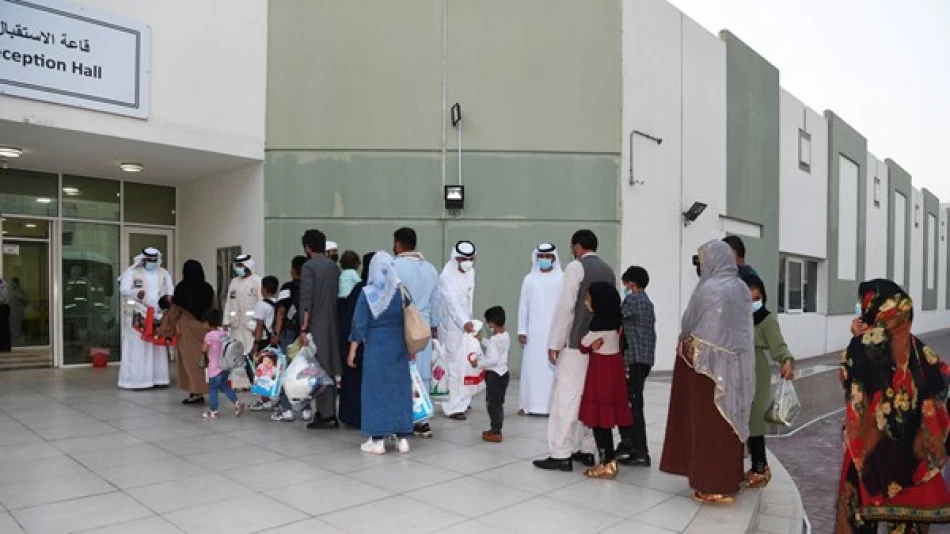
UAE Sheltered 17.6K Afghans Before Their Final Destinations
UAE's $367 Million Afghan Refugee Operation Reveals Gulf States' Growing Humanitarian Diplomacy
The United Arab Emirates has concluded one of the most comprehensive refugee assistance programs in recent history, hosting 17,619 Afghan evacuees at a cost of $367 million since the Taliban's return to power in August 2021. The operation, centered at the purpose-built "UAE Humanitarian City" in Abu Dhabi, demonstrates how Gulf states are leveraging humanitarian aid as a tool of soft power diplomacy while filling gaps left by traditional Western donors.
A Transit Hub for Global Resettlement
The UAE's approach transformed the country into a crucial transit point for Afghan refugees, facilitating the evacuation of 41,000 people including both Afghans and foreign nationals. The Emirates Humanitarian City served as a temporary home before residents moved to 21 final destinations, primarily Western countries struggling with their own processing bottlenecks.
This model addresses a critical challenge in modern refugee crises: the gap between immediate evacuation needs and lengthy resettlement procedures. While countries like Germany and Canada committed to accepting Afghan refugees, their bureaucratic processes often left evacuees in limbo. The UAE's investment essentially subsidized this transition period for the international community.
Infrastructure as Diplomatic Investment
The facility housed 17 embassy offices, including U.S. Immigration and Citizenship Services, UN Migration Agency representatives, and U.S. Customs and Border Protection offices. This arrangement allowed refugees to complete complex visa and documentation processes without leaving the compound, streamlining what typically takes months into weeks.
The setup mirrors similar initiatives by Singapore and Qatar, where strategic geographic positioning combines with substantial financial resources to create humanitarian transit hubs. However, the UAE's scale and comprehensive services—from surgical facilities to vocational training—set a new standard for such operations.
Healthcare and Education: Beyond Basic Shelter
The program's scope extended far beyond temporary accommodation. Medical teams administered 34,923 vaccines during the COVID-19 pandemic, delivered healthcare to 303 newborns, and performed over 303 surgical procedures. More than 254,572 medical services were provided, including treatment for complex cases requiring care outside the UAE.
Educational services reached 3,764 Afghans with formal schooling, while 800 children attended on-site nurseries. The UAE organized 39 training courses and professional development workshops, benefiting 2,589 Afghan adults—an investment in human capital that will benefit their eventual host countries.
Strategic Timing and Regional Competition
The UAE's humanitarian leadership comes as Gulf states compete for international influence and seek to diversify their global partnerships beyond traditional oil relationships. While Saudi Arabia focuses on mega-projects and Qatar leveraged the World Cup for soft power, the UAE has positioned itself as a reliable crisis response partner.
This approach pays diplomatic dividends. The operation strengthened UAE relationships with the United States and European allies while demonstrating the country's capacity to manage complex international challenges. For a nation seeking expanded roles in global governance, such demonstrations of competence matter significantly.
Financial Scale Reveals Strategic Priorities
The $367 million price tag for the evacuation operation represents just part of the UAE's broader Afghan commitment. An additional $200 million in humanitarian aid over three years included airlifts of food and medical supplies reaching over one million people, plus the establishment of 10 maternal health centers across seven Afghan provinces.
These figures position the UAE among Afghanistan's largest donors relative to GDP, surpassing many traditional aid providers. The investment reflects calculated strategic thinking: humanitarian leadership builds international goodwill while creating precedents for UAE involvement in future crises.
Implications for Future Refugee Response
The UAE model could reshape international refugee assistance, particularly for sudden-onset crises requiring rapid response. Traditional refugee camps, often underfunded and overcrowded, contrast sharply with the Emirates Humanitarian City's comprehensive services and dignified living conditions.
However, this approach requires substantial upfront investment that few countries can match. The UAE's success may create expectations for similar responses that prove financially unsustainable elsewhere, potentially creating a two-tier system of refugee assistance based on host country wealth rather than need.
Regional Leadership Through Humanitarian Action
The Afghan operation reinforces the UAE's broader humanitarian brand, built through disaster response in countries from Yemen to Lebanon. This consistent approach has earned the UAE recognition as a reliable partner in international crises, enhancing its bid for greater roles in global institutions.
For the UAE, humanitarian diplomacy offers unique advantages: it generates positive international coverage, builds relationships across political divides, and demonstrates state capacity without military intervention. As regional tensions persist, this soft power approach provides influence without the risks associated with hard power projection.
The program's conclusion marks not an end but a template. As climate change and political instability generate new displacement crises, the UAE has established itself as a capable intermediary—a role that serves both humanitarian needs and the country's long-term strategic interests in an increasingly multipolar world.
Most Viewed News

 Layla Al Mansoori
Layla Al Mansoori






